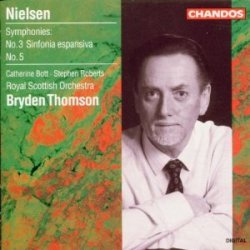Carl Nielsen - Symphony No.3 ‘Sinfonia Espansiva’ & Symphony No.5 (1992)
Carl Nielsen - Symphony No.3 ‘Sinfonia Espansiva’ & Symphony No.5 (1992)

1. Symphony No. 3 (Sinfonia Espansiva) Op. 27 (FS 60): I Allegro espansivo 2. Symphony No. 3 (Sinfonia Espansiva) Op. 27 (FS 60): II Andante pastorale 3. Symphony No. 3 (Sinfonia Espansiva) Op. 27 (FS 60): III Allegretto un poco play 4. Symphony No. 3 (Sinfonia Espansiva) Op. 27 (FS 60): IV Finale. Allegro 5. Symphony No. 5 Op. 50 (FS 97): I Tempo giusto 6. Symphony No. 5 Op. 50 (FS 97): I Tempo giusto - Adagio non troppo 7. Symphony No. 5 Op. 50 (FS 97): II Allegro 8. Symphony No. 5 Op. 50 (FS 97): II Allegro - Presto 9. Symphony No. 5 Op. 50 (FS 97): II Allegro - Andante un poco tranquillo 10. Symphony No. 5 Op. 50 (FS 97): II Allegro – Allegro play Catherine Bott - soprano Stephen Roberts - bass Royal Scottish National Orchestra Bryden Thomson – conductor
The Danish composer Carl Nielsen wrote his Symphony No. 3 "Sinfonia Espansiva", Op. 27, FS 60, between 1910 and 1911 by . It typically lasts around 33 minutes. The symphony followed Nielsen's tenure as bandmaster at the Royal Danish Opera in Copenhagen. Nielsen himself conducted the premiere of the work on February 28, 1912 with Copenhagen's Royal Danish Orchestra.
The character designation of the first movement (Allegro espansivo) serves as the symphony's subtitle, but it is not clear what Nielsen meant by 'espansiva'. Robert Simpson wrote that it suggests the "outward growth of the mind's scope". Uniquely amongst Nielsen's symphonic output, it includes vocal parts: wordless vocal solos for soprano and baritone in the second movement.
Within two months of its premiere the symphony was in the repertoire of the Royal Concertgebouw Orchestra in Amsterdam, and by 1913 it had seen performances in Germany (Stuttgart), Sweden (Stockholm) and in Finland (Helsinki). It did not receive a public performance in the United Kingdom until 1962, under Bryan Fairfax. Nielsen received 5,000 marks for publishing rights (C.F. Kahnt, Leipzig), a sum significantly higher than he usually received from his publishers. It was the first of Nielsen's symphonies to be commercially released on record, with Erik Tuxen conducting the Danish Radio Symphony Orchestra.
Symphony No. 5, Op. 50, FS 97 is a symphony composed by Carl Nielsen in Denmark between 1920 and 1922. It was first performed in Copenhagen on 24 January 1922 with the composer conducting. It is one of the two of Nielsen's six symphonies lacking a subtitle.
The Fifth Symphony has a non-customary structure, comprising two movements instead of the common three or four. Written in a modern musical language, it draws on the theme of contrast and opposition. The post-World War I composition is also described to contain elements of war.
A work from the early 20th century, the Fifth Symphony is regarded as a modernistic musical piece. The symphony draws on all of the "deformation procedures" suggested by James Hepokoski regarding musical modernism: breakthrough deformation, introduction-coda frame, episodes within developmental space, various strophic/sonata hybrids and multi-movement forms in a single movement. Its fragmented nature, unpredictable character and sudden synchronization at the ending also point towards a self-conscious modernist aesthetic, though as in most of Nielsen’s early and middle works, non-modernist devices, including organicism and diatonicism, play some essential roles.
As written in the original 1926 edition of the score, the Fifth Symphony is scored for 3 flutes (third doubling piccolo), 2 oboes, 2 clarinets, 2 bassoons, 4 horns, 3 trumpets, 3 trombones, tuba, timpani, cymbals, triangle, tambourine, snare drum, celesta, and strings. Some optional doublings are added in the 1950 edition of the score revised by Emil Telmányi and Erik Tuxen; these include the third flute doubling flute in G and the second bassoon doubling contrabassoon. These optional doublings are discarded in the latest 1998 Carl Nielsen Edition score, which was produced as a co-operation between the Danish Royal Library and Edition Wilhelm Hansen.
The Fifth Symphony has two movements instead of the usual four, which is the only time Nielsen used this structure. Nielsen explained jokingly in an interview that it was not difficult to write the first three movements of a symphony but by the finale most composers had run out of ideas. The work has a craggy profile as "it is littered with false climaxes at every turn". In summary, the first movement is a battle between the orchestra and a renegade snare-drummer, who can only be silenced by the full forces of his colleagues in the final bars. The second movement continues the struggle with shivers of anxiety, building through repetitions and detours to the final victorious grand explosion.
download: uploaded yandex 4shared mediafire solidfiles mega filecloudio nornar ziddu
Zmieniony (Niedziela, 02 Marzec 2014 17:48)








